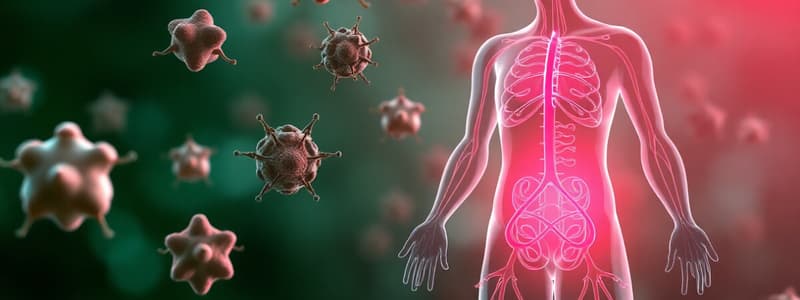Podcast
Questions and Answers
Which class of hormones is primarily composed of amino acids?
Which class of hormones is primarily composed of amino acids?
- Fatty acids
- Steroids
- Eicosanoids
- Amines (correct)
What are steroids derived from?
What are steroids derived from?
- Fatty acids
- Glucose
- Cholesterol (correct)
- Amino acids
Which of the following is NOT a type of hormone classified as amino acid-based?
Which of the following is NOT a type of hormone classified as amino acid-based?
- Prostaglandins (correct)
- Insulin
- Epinephrine
- Growth hormone
Eicosanoids are derived from which fatty acid?
Eicosanoids are derived from which fatty acid?
Which of the following hormone types includes gonadal and adrenocortical hormones?
Which of the following hormone types includes gonadal and adrenocortical hormones?
What is the primary function of gonads in the endocrine system?
What is the primary function of gonads in the endocrine system?
Which hormone is primarily regulated by the pineal gland?
Which hormone is primarily regulated by the pineal gland?
What type of hormones do gonads produce?
What type of hormones do gonads produce?
Which gland is responsible for regulating sleep patterns?
Which gland is responsible for regulating sleep patterns?
Which of the following is NOT a function of the gonads?
Which of the following is NOT a function of the gonads?
Flashcards are hidden until you start studying
Study Notes
Gonads
- Ovaries in females and testes in males produce sex hormones.
Pineal Gland
- Regulates sleep patterns through the release of melatonin.
Types of Hormones based on chemical nature
- Three main hormone types: amino acid-based, steroids, and fatty acid derived.
- Most hormones are amino acid-based, including amines (dopamine & epinephrine) and polypeptide hormones (e.g., insulin, growth hormone).
- Steroid hormones are derived from cholesterol, such as gonadal and adrenocortical hormones.
- Fatty acid-derived hormones include eicosanoids, which are derived from arachidonic acid, such as leukotrienes and prostaglandins.
Intracellular Hormone Receptors and Activation of Genes
- Hormone receptors can be located in the cell membrane, cytoplasm, or nucleus.
- Cell membrane receptors are primarily for protein, peptide, and catecholamine hormones.
- Cytoplasmic receptors are primarily for steroid hormones.
- Nuclear receptors are for thyroid hormones.
Hormone Action
- Hormones circulate to all tissues but activate only target cells.
- Target cells have specific receptors for particular hormones.
G Protein–Linked Hormone Receptors
- A hormone (first messenger) binds to the receptor, which activates a G protein inside the cell.
- G protein then activates an enzyme called adenylyl cyclase.
- Adenylyl cyclase converts ATP to cyclic adenosine monophosphate (cAMP), which acts as a second messenger.
- cAMP then activates protein kinases.
- Protein kinases activate other proteins that ultimately produce a specific cellular effect.
Studying That Suits You
Use AI to generate personalized quizzes and flashcards to suit your learning preferences.




